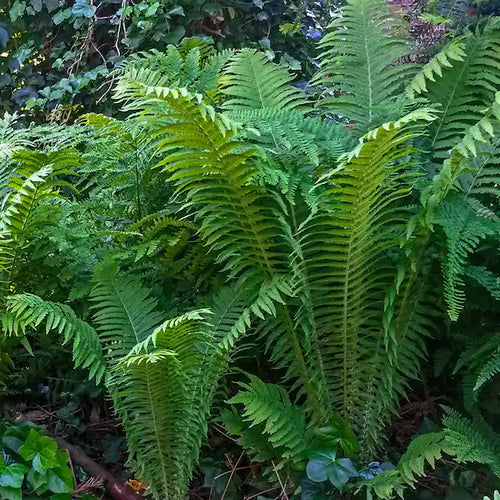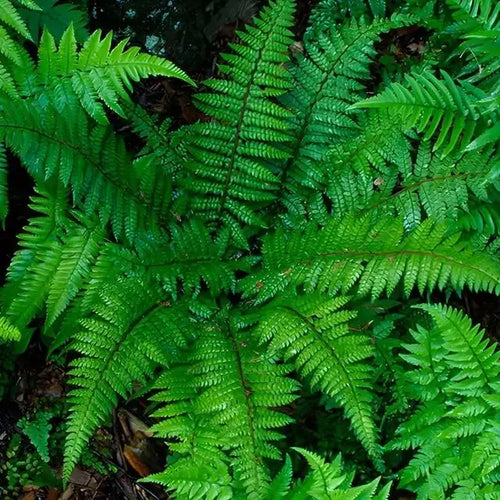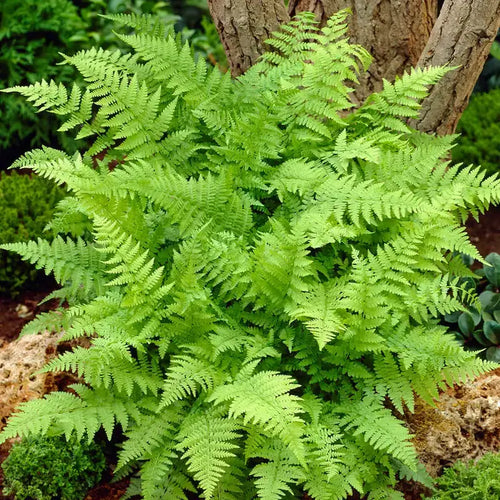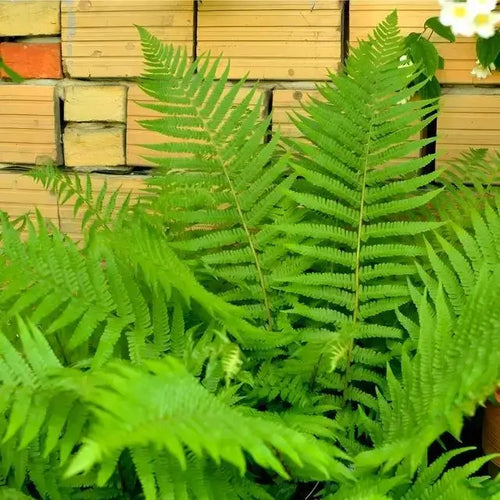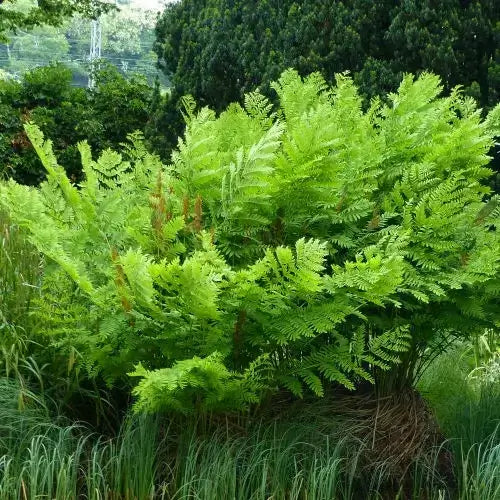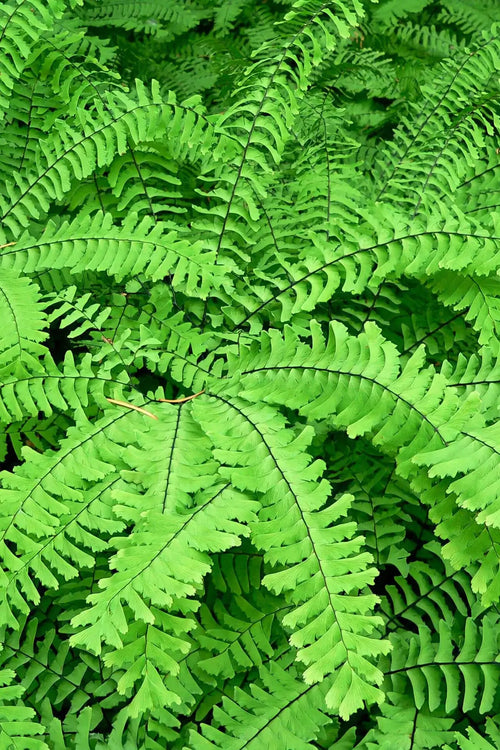Ferns for Partial Sun Areas
Ferns are captivating plants known for their delicate fronds and ability to thrive in various environments. While many ferns are associated with shady, damp forests, several species can thrive in partial sun areas. These ferns offer a unique and elegant touch to gardens, patios, and landscapes that receive dappled sunlight or limited exposure to direct sun.
Find the top 10 best types of ferns that are well-suited for partial sun areas, discussing their characteristics, care requirements, and how to incorporate them into your outdoor spaces.
1. Japanese Painted Fern (Athyrium niponicum)
The Japanese Painted Fern is famous for partial sun areas due to its stunning metallic silver and burgundy fronds. It thrives in moist to moderate sunlight. This fern is a perfect addition to shaded borders, woodland gardens, or containers. Ensure consistent moisture and protect it from the harsh afternoon sun.
2. Ostrich Fern (Matteuccia struthiopteris)
The Ostrich Fern is known for its large, feathery fronds that resemble ostrich plumes. It prefers consistently moist soil and can tolerate partial sun conditions. This fern can create a lush, dramatic focal point in gardens and along water features. However, preventing the ground from drying is essential, especially during the growing season.
3. Christmas Fern (Polystichum acrostichoides)
The Christmas Fern is a native of North America that can tolerate partial sun to dappled shade. Its glossy, dark green fronds make it versatile for various garden styles. This fern is well-suited for woodland, rock, and naturalized areas. It's relatively low-maintenance and can tolerate a range of soil conditions.
4. Autumn Fern (Dryopteris erythrosora)
The Autumn Fern is prized for its unique coppery-red new growth that gradually matures to a deep green. It thrives in partial sun to light shade and is adaptable to different soil types. This fern adds warmth and texture to shaded borders and mixed perennial beds. Regular watering and well-draining soil are essential for its health.
5. Lady Fern (Athyrium filix-femina)
Lady Ferns are elegant, feathery ferns that can thrive in partial sun areas. They prefer consistently moist soil and can handle dappled sunlight. These ferns can be used in woodland gardens, shaded borders, and naturalistic landscapes. They are relatively low-maintenance but require regular watering to moisten the soil.
6. Cinnamon Fern (Osmundastrum cinnamomeum)
The Cinnamon fern can thrive in partial sunlight. This fern species is versatile and can live in both full and partial-shade environments. It adapts to various light conditions. Whether planted in full to partial shade or even in areas with at least 3 hours of direct sunlight, the Cinnamon Fern makes an excellent choice for shade gardens, woodlands, and native plant landscapes.
7. Royal Fern (Osmunda regalis)
The Royal Fern is a grand, statuesque fern that can tolerate partial sun to light shade. Its elegant, arching fronds can reach impressive heights. This fern is an excellent choice for waterside plantings, rain gardens, and large containers. It thrives in consistently moist soil and appreciates high humidity levels.
8. Interrupted Fern
The Interrupted Fern gets its name from the unique structure of its fertile fronds that appear to be "interrupted" by sterile leaflets. It can tolerate partial sun to light shade and prefers moist, well-drained soil. This fern adds a touch of curiosity and interest to shaded gardens and woodland areas. Regular watering and soil moisture are crucial for its growth.
9. Western Sword Fern (Polystichum munitum)
The Western Sword Fern is a native fern of the Pacific Northwest that can tolerate partial sun conditions. Its robust, dark green fronds are a characteristic feature of woodland landscapes. This fern is well-suited for naturalistic plantings, shaded borders, and rock gardens. It prefers well-draining soil and benefits from regular watering.
10. Maidenhair Fern (Adiantum spp.)
Maidenhair Ferns are known for their delicate, fan-shaped fronds and airy appearance. While most ferns prefer shade, certain species of Maidenhair Ferns, such as the Northern Maidenhair (Adiantum pedatum), can tolerate partial sun conditions. These ferns can bring a touch of grace to shaded patios, container gardens, and woodland settings. They require consistent moisture and well-draining soil.
Incorporating ferns into partial sun areas can add texture, color, and elegance to outdoor spaces.
From the striking metallic fronds of the Japanese Painted Fern to the delicate fan-shaped leaves of the Maidenhair Fern, various fern species can thrive and flourish with limited exposure to sunlight. Remember that while these ferns can tolerate partial sun, they require consistent moisture and well-draining soil to ensure their health and vitality. By selecting suitable ferns, you can create a lush and captivating garden that embraces the unique beauty of these remarkable plants.
While ferns are often associated with shade-loving plants, many varieties flourish in dappled sunlight, making them versatile and enchanting to gardens, patios, and landscapes. The allure of ferns lies in their remarkable resilience and the diversity they bring to the visual palette of any outdoor setting. Their delicately feathery fronds create a soothing contrast to coarser foliage, introducing a touch of finesse and softness. The interplay of light and shadow on their intricate leaves can evoke a sense of enchantment, making them a natural focal point that draws the eye.
What sets ferns apart is their remarkable ability to enhance the ambiance with their array of hues. Some varieties develop striking shades of vibrant greens, while others take on a more subdued, almost silvery tone that adds depth and dimension to the landscape. As the sun filters through the foliage, it casts an enchanting glow, bringing out the full spectrum of colors in the ferns' leaves.
Elegance exudes from every inch of these plants, as they evoke a timeless beauty that complements traditional and modern outdoor designs. Ferns' arching and unfurling fronds provide a sense of movement and grace, imbuing outdoor spaces with sophistication. Their presence effortlessly elevates the aesthetic, adding a touch of refinement that can transform even the most straightforward corners into captivating nooks.
Caring for ferns in partial sun areas is easy, making them an excellent choice for gardeners of all experience levels.
Adequate moisture and well-draining soil are essential, and a reasonable approach to sunlight ensures they thrive without becoming scorched. Their adaptability allows them to flourish in various environments, from shaded corners to spots that receive a gentle dose of the sun throughout the day.
Incorporating ferns into partially sunny areas brings a symphony of natural beauty to outdoor spaces. Their textures, colors, and innate elegance harmonize to create an outdoor sanctuary that soothes the senses and delights the soul. Whether tucked amidst a lush garden or gracing a secluded patio, ferns are a testament to nature's artistry, breathing life, and enchantment into every corner they inhabit.
Visit our online shop for a wide selection of plants and trees, or come say hi at our store location in Tennessee!
We offer fast shipping nationwide so you can start transforming your garden today!
If you have any questions about ferns or if you have any other plant needs, don’t hesitate to contact us at customerservice@tennesseewholesalenursery.com, we’d love to hear from you!
